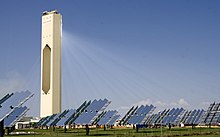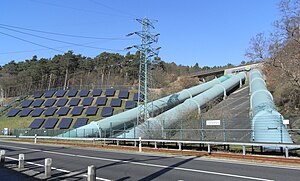Solar power

| Renewable energy |
|---|
|
Biofuel |
|
|
Solar power is the conversion of sunlight into electricity, either directly using photovoltaics (PV), or indirectly using concentrated solar power (CSP) or to split water and create hydrogen fuel using techniques of artificial photosynthesis. Concentrated solar power systems use lenses or mirrors and tracking systems to focus a large area of sunlight into a small beam. Photovoltaics converts light into electric current using the photoelectric effect.[1]
Commercial concentrated solar power plants were first developed in the 1980s, and the 354 MW SEGS CSP installation is the largest solar power plant in the world and is located in the Mojave Desert of California. Other large CSP plants include the Solnova Solar Power Station (150 MW) and the Andasol solar power station (100 MW), both in Spain. The 97 MW Sarnia Photovoltaic Power Plant in Canada, is the world’s largest photovoltaic plant.
Contents[hide] |
Applications

Solar power has great potential, but in 2008 supplied less than 0.02% of the world's total energy supply[citation needed]. There are many competing technologies, including 14 types of photovoltaic cells, such as thin film, monocrystalline silicon, polycrystalline silicon, and amorphous cells, as well as multiple types of concentrating solar power. It is too early to know which technology will become dominant.[2]
The earliest significant application of solar cells was as a back-up power source to the Vanguard I satellite in 1958, which allowed it to continue transmitting for over a year after its chemical battery was exhausted.[3] The successful operation of solar cells on this mission was duplicated in many other Soviet and American satellites, and by the late 1960s, PV had become the established source of power for them.[4] Photovoltaics went on to play an essential part in the success of early commercial satellites such as Telstar, and they remain vital to the telecommunications infrastructure today.[5]
The high cost of solar cells limited terrestrial uses throughout the 1960s. This changed in the early 1970s when prices reached levels that made PV generation competitive in remote areas without grid access. Early terrestrial uses included powering telecommunication stations, off-shore oil rigs, navigational buoys and railroad crossings.[6] These off-grid applications accounted for over half of worldwide installed capacity until 2004.[7]

The 1973 oil crisis stimulated a rapid rise in the production of PV during the 1970s and early 1980s.[8] Economies of scale which resulted from increasing production along with improvements in system performance brought the price of PV down from 100 USD/watt in 1971 to 7 USD/watt in 1985.[9] Steadily falling oil prices during the early 1980s led to a reduction in funding for photovoltaic R&D and a discontinuation of the tax credits associated with the Energy Tax Act of 1978. These factors moderated growth to approximately 15% per year from 1984 through 1996.[10]
Since the mid-1990s, leadership in the PV sector has shifted from the US to Japan and Europe. Between 1992 and 1994, Japan increased R&D funding, established net metering guidelines, and introduced a subsidy program to encourage the installation of residential PV systems.[11] As a result, PV installations in the country climbed from 31.2 MW in 1994 to 318 MW in 1999,[12] and worldwide production growth increased to 30% in the late 1990s.[13]
Germany became the leading PV market worldwide since revising its Feed-in tariff system as part of the Renewable Energy Sources Act. Installed PV capacity has risen from 100 MW in 2000 to approximately 4,150 MW at the end of 2007.[14][15] After 2007, Spain became the largest PV market after adopting a similar feed-in tariff structure in 2004, installing almost half of the photovoltaics (45%) in the world, in 2008, while France, Italy, South Korea and the US have seen rapid growth recently due to various incentive programs and local market conditions.[16] Recent Studies have shown that the global PV market is forecast to exceed 16 GW in the year 2010.[17] The power output of domestic photovoltaic devices is usually described in kilowatt-peak (kWp) units, as most are from 1 to 10 kW.[18]
A significant problem with solar power is the capital installation cost, although cost has been decreasing due to the learning curve.[19] Developing countries in particular may not have the funds to build solar power plants, although small solar applications are now replacing other sources in the developing world.[20][21]
Concentrating solar power

Concentrating Solar Power (CSP) systems use lenses or mirrors and tracking systems to focus a large area of sunlight into a small beam. The concentrated heat is then used as a heat source for a conventional power plant. A wide range of concentrating technologies exists; the most developed are the parabolic trough [discuss], the concentrating linear fresnel reflector, the Stirling dish and the solar power tower. Various techniques are used to track the Sun and focus light. In all of these systems a working fluid is heated by the concentrated sunlight, and is then used for power generation or energy storage.[22]
A parabolic trough consists of a linear parabolic reflector that concentrates light onto a receiver positioned along the reflector's focal line. The receiver is a tube positioned right above the middle of the parabolic mirror and is filled with a working fluid. The reflector is made to follow the Sun during the daylight hours by tracking along a single axis. Parabolic trough systems provide the best land-use factor of any solar technology.[23] The SEGS plants in California and Acciona's Nevada Solar One near Boulder City, Nevada are representatives of this technology.[24][25] Compact Linear Fresnel Reflectors are CSP-plants which use many thin mirror strips instead of parabolic mirrors to concentrate sunlight onto two tubes with working fluid. This has the advantage that flat mirrors can be used which are much cheaper than parabolic mirrors, and that more reflectors can be placed in the same amount of space, allowing more of the available sunlight to be used. Concentrating linear fresnel reflectors can be used in either large or more compact plants.[26][27]
The Stirling solar dish combines a parabolic concentrating dish with a Stirling engine which normally drives an electric generator. The advantages of Stirling solar over photovoltaic cells are higher efficiency of converting sunlight into electricity and longer lifetime. Parabolic dish systems give the highest efficiency among CSP technologies.[28] The 50 kW Big Dish in Canberra, Australia is an example of this technology.[24]
A solar power tower uses an array of tracking reflectors (heliostats) to concentrate light on a central receiver atop a tower. Power towers are more cost effective, offer higher efficiency and better energy storage capability among CSP technologies.[24] The Solar Two in Barstow, California and the Planta Solar 10 in Sanlucar la Mayor, Spain are representatives of this technology.[24][29]
Photovoltaics
A solar cell, or photovoltaic cell (PV), is a device that converts light into electric current using the photoelectric effect. The first solar cell was constructed by Charles Fritts in the 1880s.[30] In 1931 a German engineer, Dr Bruno Lange, developed a photo cell using silver selenide in place of copper oxide.[31] Although the prototype selenium cells converted less than 1% of incident light into electricity, both Ernst Werner von Siemens and James Clerk Maxwell recognized the importance of this discovery.[32] Following the work of Russell Ohl in the 1940s, researchers Gerald Pearson, Calvin Fuller and Daryl Chapin created the silicon solar cell in 1954.[33] These early solar cells cost 286 USD/watt and reached efficiencies of 4.5–6%.[34]
Development and deployment

The early development of solar technologies starting in the 1860s was driven by an expectation that coal would soon become scarce. However, development of solar technologies stagnated in the early 20th century in the face of the increasing availability, economy, and utility of coal and petroleum.[35] In 1974 it was estimated that only six private homes in all of North America were entirely heated or cooled by functional solar power systems.[36] The 1973 oil embargo and 1979 energy crisis caused a reorganization of energy policies around the world and brought renewed attention to developing solar technologies.[37][38] Deployment strategies focused on incentive programs such as the Federal Photovoltaic Utilization Program in the US and the Sunshine Program in Japan. Other efforts included the formation of research facilities in the US (SERI, now NREL), Japan (NEDO), and Germany (Fraunhofer Institute for Solar Energy Systems ISE).[39]
Between 1970 and 1983 photovoltaic installations grew rapidly, but falling oil prices in the early 1980s moderated the growth of PV from 1984 to 1996. Since 1997, PV development has accelerated due to supply issues with oil and natural gas, global warming concerns, and the improving economic position of PV relative to other energy technologies.[40] Photovoltaic production growth has averaged 40% per year since 2000 and installed capacity reached 10.6 GW at the end of 2007,[7] and 14.73 GW in 2008.[41] As of November 2010, the largest photovoltaic (PV) power plants in the world are the Finsterwalde Solar Park (Germany, 80.7 MW), Sarnia Photovoltaic Power Plant (Canada, 80 MW), Olmedilla Photovoltaic Park (Spain, 60 MW), the Strasskirchen Solar Park (Germany, 54 MW), the Lieberose Photovoltaic Park (Germany, 53 MW), and the Puertollano Photovoltaic Park (Spain, 50 MW).[42]
PV power station |
Country |
DC peak power (MWp)  |
Notes |
|---|---|---|---|
| Sarnia Photovoltaic Power Plant[43] | Canada | 97[42] | Constructed 2009-2010[44] |
| Montalto di Castro Photovoltaic Power Station[42] | Italy | 84.2 | Constructed 2009-2010 |
| Finsterwalde Solar Park[45][46] | Germany | 80.7 | Phase I completed 2009, phase II and III 2010 |
| Rovigo Photovoltaic Power Plant[47][48] | Italy | 70 | Completed November 2010 |
| Olmedilla Photovoltaic Park | Spain | 60 | Completed September 2008 |
| Strasskirchen Solar Park | Germany | 54 | |
| Lieberose Photovoltaic Park [49][50] | Germany | 53 | Completed in 2009 |
| Puertollano Photovoltaic Park | Spain | 50 | 231,653 crystalline silicon modules, Suntech and Solaria, opened 2008 |
Commercial concentrating solar thermal power (CSP) plants were first developed in the 1980s. The 11 MW PS10 power tower in Spain, completed in late 2005, is Europe's first commercial CSP system, and a total capacity of 300 MW is expected to be installed in the same area by 2013.[51] When built, the Ivanpah Solar Power Facility in southeastern California near the Nevada border is expected to have a capacity of 392 Megawatts.
| Capacity (MW)  |
Name |
Country |
Location |
Notes |
|---|---|---|---|---|
| 354 | Solar Energy Generating Systems | Mojave Desert California | Collection of 9 units | |
| 150 | Solnova Solar Power Station | Seville | Completed 2010 [52][53][54][55][56] |
|
| 100 | Andasol solar power station | Granada | Completed 2009 [57][58] |
|
| 64 | Nevada Solar One | Boulder City, Nevada | ||
| 50 | Ibersol Ciudad Real | Puertollano, Ciudad Real | Completed May 2009 [59] | |
| 50 | Alvarado I | Badajoz | Completed July 2009 [60][61][62] | |
| 50 | Extresol 1 | Torre de Miguel Sesmero (Badajoz) | Completed February 2010 [63][64][65] | |
| 50 | La Florida | Alvarado (Badajoz) | completed July 2010 [63][66] |
Economics
The U.S. Energy Information Administration calculates that, all-told, electricity from a Solar PV plants costs 4 times that of conventional coal.[67] Bloomburg energy estimates that solar power costs about $275 per megawatt-hour to produce compared with $60 for a coal-fired power plant.[68] Nevertheless, there are exceptions-- Nellis Air Force Base is receiving photoelectric power for about 2.2 ¢/kWh and grid power for 9 ¢/kWh.[69][70] Also, since PV systems use no fuel and modules typically last 25 to 40 years, the International Conference on Solar Photovoltaic Investments, organized by EPIA, has estimated that PV systems will pay back their investors in 8 to 12 years.[71] As a result, since 2006 it has been economical for investors to install photovoltaics for free in return for a long term power purchase agreement. Fifty percent of commercial systems were installed in this manner in 2007 and it is expected that 90% will by 2009.[72]
Concentrated Solar Power (CSP) facilities produce power more cheaply than photovoltaic systems and may eventually be price-competitive with conventional power plants. The Ivanpah Solar Power Facility is expected to produce power at costs comparable to natural gas.[73]
Additionally, governments have created various financial incentives to encourage the use of solar power. Renewable portfolio standards impose a government mandate that utilities generate or acquire a certain percentage of renewable power regardless of increased energy procurement costs. In most states, RPS goals can be achieved by any combination of solar, wind, biomass, landfill gas, ocean, geothermal, municipal solid waste, hydroelectric, hydrogen, or fuel cell technologies.[73] In Canada, the Renewable Energy Standard Offer Program (RESOP), introduced in 2006[74] and updated in 2009 with the passage of the Green Energy Act, allows residential homeowners in Ontario with solar panel installations to sell the energy they produce back to the grid (i.e., the government) at 42¢/kWh, while drawing power from the grid at an average rate of 6¢/kWh.[75] The program is designed to help promote the government's green agenda and lower the strain often placed on the energy grid at peak hours. In March, 2009 the proposed FIT was increased to 80¢/kWh for small, roof-top systems (≤10 kW).[76]
One financial disincentive to solar power is the large land area required. A 1000 Megawatt CSP facility requires 6000 acres of land while a similar coal-fired plant requires less than 640 acres of land. Producing 1000 Megawatts from photovoltaics requires over 12,000 acres of land.[77] In the US, power companies may avoid purchasing land by leasing public land from the federal government to develop solar power facilities; however this entails different costs such as rental fees, megawatt surcharges, and the cost of compliance with a complex and time-consuming federal permitting process.[78]
Energy storage methods

Solar energy is not available at night, making energy storage an important issue in order to provide the continuous availability of energy.[79] Both wind power and solar power are intermittent energy sources, meaning that all available output must be taken when it is available and either stored for when it can be used, or transported, over transmission lines, to where it can be used. Wind power and solar power tend to be somewhat complementary, as there tends to be more wind in the winter and more sun in the summer, but on days with no sun and no wind the difference needs to be made up in some manner.[80] The Institute for Solar Energy Supply Technology of the University of Kassel pilot-tested a combined power plant linking solar, wind, biogas and hydrostorage to provide load-following power around the clock, entirely from renewable sources.[81]
Solar energy can be stored at high temperatures using molten salts. Salts are an effective storage medium because they are low-cost, have a high specific heat capacity and can deliver heat at temperatures compatible with conventional power systems. The Solar Two used this method of energy storage, allowing it to store 1.44 TJ in its 68 m³ storage tank, enough to provide full output for close to 39 hours, with an efficiency of about 99%.[82]
Off-grid PV systems have traditionally used rechargeable batteries to store excess electricity. With grid-tied systems, excess electricity can be sent to the transmission grid. Net metering programs give these systems a credit for the electricity they deliver to the grid. This credit offsets electricity provided from the grid when the system cannot meet demand, effectively using the grid as a storage mechanism. Credits are normally rolled over month to month and any remaining surplus settled annually.[83]
Pumped-storage hydroelectricity stores energy in the form of water pumped when surplus electricity is available, from a lower elevation reservoir to a higher elevation one. The energy is recovered when demand is high by releasing the water: the pump becomes a turbine, and the motor a hydroelectric power generator.[84]
Artificial photosynthesis involves the use of nanotechnology to store solar electromagnetic energy in chemical bonds, by splitting water to produce hydrogen fuel or then combining with carbon dioxide to make biopolymers such as methanol. Many large national and regional research projects on artificial photosynthesis are now trying to develop techniques integrating improved light capture, quantum coherence methods of electron transfer and cheap catalytic materials that operate under a variety of atmospheric conditions.[85]
Experimental solar power
Concentrated photovoltaics (CPV) systems employ sunlight concentrated onto photovoltaic surfaces for the purpose of electrical power production. Solar concentrators of all varieties may be used, and these are often mounted on a solar tracker in order to keep the focal point upon the cell as the Sun moves across the sky.[86] Luminescent solar concentrators (when combined with a PV-solar cell) can also be regarded as a CPV system. Luminescent solar concentrators are useful as they can improve performance of PV-solar panels drastically.[87]
Thermoelectric, or "thermovoltaic" devices convert a temperature difference between dissimilar materials into an electric current. First proposed as a method to store solar energy by solar pioneer Mouchout in the 1800s,[88] thermoelectrics reemerged in the Soviet Union during the 1930s. Under the direction of Soviet scientist Abram Ioffe a concentrating system was used to thermoelectrically generate power for a 1 hp engine.[89] Thermogenerators were later used in the US space program as an energy conversion technology for powering deep space missions such as Cassini, Galileo and Viking. Research in this area
نظرات شما عزیزان:







